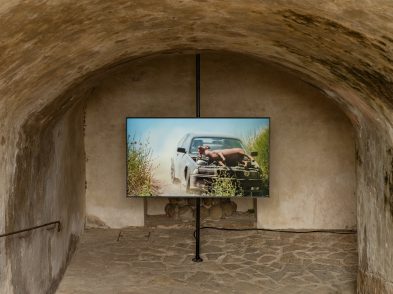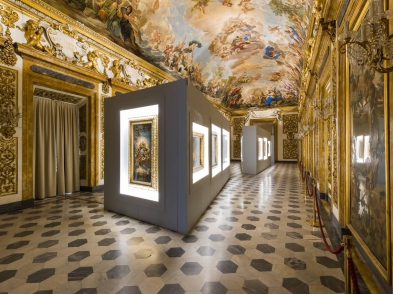Beauty is a concept not immediately associated with visual art in the modern era. Although some artists pioneered the sublime detachment of abstraction, others appeared more concerned with the turmoil, grittiness and uncertainty of existence. Indeed, many practitioners may even have regarded the pursuit of beauty as irrelevant, even irresponsible. If that perception ever has been the reality, are attitudes now widely changing? The current exhibition at the Centre for Contemporary Culture Strozzina explores, through the work of eight European artists, how beauty is being defined within art today.

Everyone has their own idea of what is beautiful. And the general opinion, inside and outside the profession, is that artists abandoned beauty as their primary goal at least 100 years ago.
In place of the ideal came other concerns: self-expression, science, materiality, the psyche and accounts of everyday life increasingly subject to the extremes made possible by technology.
But beauty is notoriously hard to define. If an idea, history or action can be as enchanting as sensuous form, beauty is only describable by its effect on like-minded individuals—or by its total absence.

The British philosopher Roger Scruton recently compared the experience of beauty with the sensation that ‘we are at home in the world, that the world is already ordered in our perceptions as a place fit for the lives of beings like us.’
This distinctly rational explanation finds rapport among the artists, four women and four men, chosen by Florence’s Strozzina Centre of Contemporary Art to illustrate its proposition that beauty remains a valid theme in art.
Indeed, home is the subject of Anri Sala’s film. An Albanian now settled in Berlin, Sala documents the campaign in 2003 by Edi Rama, Tirana’s mayor, to humanise the grim architectural legacy of the communist era.

Rama is Sala’s friend and has himself been an artist. With the simple expedient of painting the façades of concrete housing blocks, residential districts were transformed into giant conceptual artworks involving real people.
Bright colour, a common emblem of beautification, became the agent to galvanise the public for regeneration. Critics viewed the strategy as costly and cosmetic in a city without reliable utilities.
But supporters welcomed an inspirational gesture for raising spirits and encouraging social interaction after financial scandals followed decades of harsh dictatorship.
By contrast, Vanessa Beecroft uses colour to subvert the feminine form, a generic icon of beauty. Her film presents a tableau vivant of silent young women, all painted back and resembling charred survivors. They are seen standing, sitting and lounging, perhaps waiting, on a slab-like indoor stage at Naples’ former fish market.
Her images are highly sought after and their appeal is hard to pin down. An Italian based in Los Angeles, Beecroft creates tense, heavily staged compositions, most often featuring women posed sculpturally like fashion models, aloof from the spectator and one another.
Yet the context remains ambiguous. The girls’ exposed, naked presence is more disturbing than alluring. While some observers believe Beecroft demeans women, others maintain she empowers her subject by reclaiming sexualised images from the mass media stereotype. Looking and being looked at become protagonists in a wordless drama.
Jean-Luc Mylayne’s photographs, like Beecroft’s, are not all they first appear to be, namely views of natural panoramas and birdlife. With sustained observation, such as that which birdwatchers employ, we become aware of other priorities, offered as uncanny details such as variable depths of focus, subtle repetitions and inversions.
Although every element in front of the camera appears natural, the picture looks contrived. Nature is manipulated to be more striking and more, well, beautiful. Thoughts about ornithology and landscape dissolve into a philosophical reflection on what our absorption in the image reveals.
Does that intellectual energy constitute beauty? Tellingly, titles stress time—the months of planning, scouting and waiting—and the work’s place in the patient, numerical sequence of the maker’s spare output. Details of place and bird type, being irrelevant, are omitted.
Modern software can gild the lily imperceptibly. Andreas Gefeller uses his camera like an autonomous scanner to gather information that he then converts into carefully modified, formal compositions.
To make his Poles series, Gefeller used Photoshop to enhance the reality of what the lens saw. The geometric patterns of cables and switches radiating overhead from communication masts are recognisable in terms of visual experience and abstract art, a bipolarity of nature and culture that Gefeller evidently enjoys.
But is that beauty? By allowing the artists to share their interpretation, this exhibition draws no conclusion and lets the viewer decide.
Beauty, being subjective, is unachievable in pure, unmediated form. Yet stalking many exhibits is the modern preoccupation with debased values and cosmetic refinements. Its effect is double-edged in a show that pursues its theme mostly at a conceptual level rather than by targeting the senses.
Yet two artists do propose a more tactile experience of beauty. Chiara Camoni’s arrangement of diverse marble fragments locates beauty in the handling and shaping of materials in which reside collective assumptions of past resonances.
Meanwhile, the human dimension interests Polish artist Wilhelm Sasnal. The first impression may be that Sasnal makes photographs: his images accord with the current fashion for banal subjects and abruptly cropped portraits.
As closer inspection reveals juicy paint strokes, that illusion is soon dispelled. Indeed, this artist emphasises the materiality of his media; details introduce an emotional sensibility absent elsewhere in this show.
When Sasnal paints long, grey sheds in a bucolic landscape on a large canvas and titles the image Pigsty, he coaxes us to suspect a sinister presence in the outward ordinariness.
He resists declaring his intention but musters clues in which we interpret his message. Farming on this scale, the elements suggest, implies factory methods at odds with nature.
Sasnal wants his twin roles as participant in the world of events and as painter to be complementary. Mixing styles and genres, public comment with private sentiment, his painting assumes integrity forfeited by the camera in recent years.
If beauty suffers in translation to image, the elusive character of the concept is simply confirmed. While no contemporary artist is unaware that the pursuit of beauty dominated art for centuries, few want to place it at the centre of their practice.
The idea of beauty survives as a concern of artists, but as one among many that a single significant work, let alone one career, encompasses today.
AN IDEA OF BEAUTY Until July 28, 2013
Centre for Contemporary Culture Strozzina
Palazzo Strozzi, Piazza Strozzi 50123 Florence, www.strozzina.org






